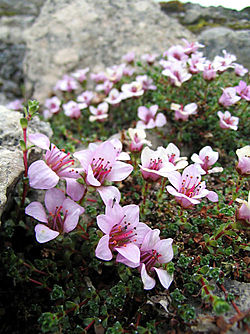In 2002 Plantlife conducted a "County Flowers" public survey to assign flowers to each of the counties of the United Kingdom and the Isle of Man. [1] The results of this campaign designated a single plant species to a "county or metropolitan area" in the UK and Isle of Man. [2] Some English counties already had flowers traditionally associated with them before 2002, [3] and which were different from those assigned to them by Plantlife, including the white rose for Yorkshire (assigned the harebell), the poppy for Norfolk (assigned the Alexanders), and the cowslip for Essex (assigned the poppy). Some flowers were assigned to multiple counties.
| County | Image | Common name | Scientific name | County status | Shared |
|---|---|---|---|---|---|
| Isle of Man [b] |  | fuchsia [53] | Fuchsia magellanica | neophyte |
| County | Image | Common name | Scientific name | County status | Shared |
|---|---|---|---|---|---|
| Antrim |  | harebell [51] | Campanula rotundifolia | native | Dumfriesshire & Yorkshire |
| Armagh |  | cowbane [54] | Cicuta virosa | native | |
| Belfast |  | gorse [55] | Ulex europaeus | native | |
| Londonderry |  | purple saxifrage [56] | Saxifraga oppositifolia | native | |
| Down |  | spring squill [57] | Scilla verna | native | |
| Fermanagh |  | globeflower [58] | Trollius europaeus | native | |
| Tyrone |  | bog-rosemary [59] | Andromeda polifolia | native | Ceredigion & Kirkcudbright |
| County | Image | Common name | Scientific name | County status | Shared |
|---|---|---|---|---|---|
| Anglesey |  | spotted rock-rose [90] | Tuberaria guttata | native | |
| Brecknockshire |  | cuckooflower [10] | Cardamine pratensis | native | Cheshire |
| Caernarfonshire |  | Snowdon lily [91] | Gagea serotina , syn. Lloydia serotina | native | |
| Cardiff |  | wild leek [92] | Allium ampeloprasum | native | |
| Carmarthenshire |  | whorled caraway [93] | Carum verticillatum | native | |
| Ceredigion |  | bog-rosemary [59] | Andromeda polifolia | native | Kirkcudbright & Tyrone |
| Denbighshire |  | limestone woundwort [94] | Stachys alpina | native | |
| Flintshire |  | bell heather [95] | Erica cinerea | native | |
| Glamorgan |  | yellow whitlow-grass [96] | Draba aizoides | native | |
| Merioneth |  | Welsh poppy [97] | Papaver cambricum | native | |
| Monmouthshire |  | foxglove [28] | Digitalis purpurea | native | Argyll, Leicestershire & West Midlands |
| Montgomeryshire |  | spiked speedwell [98] | Veronica spicata | native | |
| Pembrokeshire |  | thrift [24] | Armeria maritima | native | Bute & Isles of Scilly |
| Radnorshire |  | Radnor lily [99] | Gagea bohemica | native |